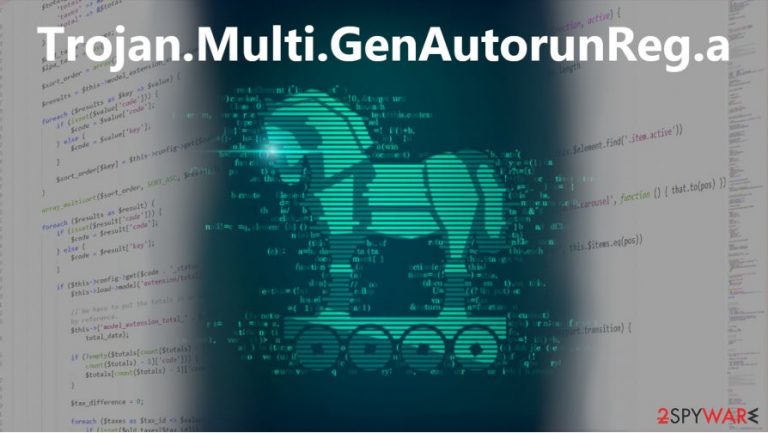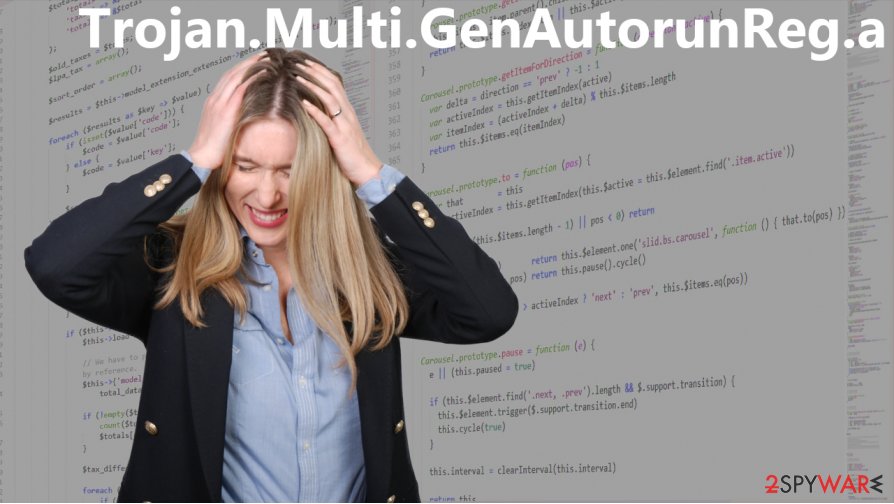Trojan.Multi.GenAutorunReg.a (Removal Guide) - Free Instructions
Trojan.Multi.GenAutorunReg.a Removal Guide
What is Trojan.Multi.GenAutorunReg.a?
Trojan.Multi.GenAutorunReg.a is the trojan that mainly spreads in Russia and aims to steal data

Trojan.Multi.GenAutorunReg.a is a variant of a trojan horse that aims to access sensitive information and control processes running on the machine. It might also be set to steal that data or control other functions of the system. It is a virus that researchers report to stop mainly in devices used in regions like Russia, Vietnam, and India the most. It doesn't mean that you cannot get this virus or any other GenAutorunReg – type of malware in other places in the world. The main issue with this virus is the stealthy infiltration ad possible damage that can be done to the machine while the infection silently runs in the background.
| Name | Trojan.Multi.GenAutorunReg.a |
|---|---|
| Type | Trojan/ malware |
| Issues | Threat runs in the background and cannot be easily spotted or removed. Meanwhile, trojan can steal data, damage the machine, and infiltrate other malware on the PC. It might be designed to spread ransomware and do nothing else |
| Distribution | Malicious macros[1] and other threats can spread trojans quickly |
| Elimination | You need to remove Trojan.Multi.GenAutorunReg.a as soon as possible, so you should rely on anti-malware tools for that |
| Repair | Make sure to repair the OS and other files, programs with FortectIntego |
Trojan.Multi.GenAutorunReg.a is a dangerous threat and might be difficult to remove and even spot on the infected computer. It uses specific software and techniques to conceal itself from the user and security tools, antivirus applications. This is the reason why the threat is one of the more damaging malware, and many experts[2] recommend relying on powerful AV tools.
One of the best ways to remove Trojan.Multi.GenAutorunReg.a is by running a scan with SpyHunter 5Combo Cleaner or Malwarebytes. These tools can provide a proper system check and indicate all the threats, files, programs that affect your machine without your knowledge.
Trojan.Multi.GenAutorunReg.a is a detection name that can be shown on the list of AV engine scans, but you shouldn't focus on particular names or heuristic results because the sam malware can get detected by different tools with a specific or a general name. It depends strongly on the database of the specific anti-malware program. You might get this alter with a trojan name out of nowhere, if so – remove it ASAP.

Trojan.Multi.GenAutorunReg.A might replace required files to run actively it may also open a connection to a remote host, so there are many risks of getting hacked or receive another malware this way. Once the access to your device is opened for another actor, the trojan may begin to use the following tools:
- Keyloggers;[3]
- Downloaders;
- Tools to monitor the infected PC’s screen and take screenshots;
- Tools for controlling the hardware of the computer – CPU, graphics driver, CD/DVD, USB drives;
- File explorer tools.
Trojan.Multi.GenAutorunReg.a removal is crucial for the security of the machine, but remember to recover the operating system, altered or corrupted files. For that, you need tools that can find and fix such issues for you. So FortectIntego can be one of them. You can also find a few tips below for the proper trojan termination.
Paying attention to details is key in avoiding threats
The trojan attack happens in different ways. One of them is by opening an infected email attachment from the shady sender. In most cases, spam messages that have the malware payload in their attachments contain more files in the email. Various common subject lines try to lure users into opening the infected one.
The legitimate files may be of the following extensions: doc, pdf, doc, jpeg. Instead of safe files, there may be an infected file containing the malicious payload of the malware. You should be cautious in what emails you open online and always use spam filters that block out emails. Keeping AV tools can also help to block malware from possible infections.
Clean the system fully from Trojan.Multi.GenAutorunReg.a virus traces
There are many files and programs that can be related to Trojan.Multi.GenAutorunReg.a, so you should remove them all to terminate the malware properly. You cannot achieve that manually because trojan has no particular files and apps that could be uninstalled.
Trojan.Multi.GenAutorunReg.a removal process should start with anti-malware tools, so you can find and eliminate all pieces. SpyHunter 5Combo Cleaner or Malwarebytes tools can help you with a proper system check and termination of various types of malware.
When you remove Trojan.Multi.GenAutorunReg.a using anti-malware tools, your device should immediately work better than before. However, you might need to repair registry entries, other issues. For that – run FortectIntego.
Getting rid of Trojan.Multi.GenAutorunReg.a. Follow these steps
Manual removal using Safe Mode
You can try to reboot the machine in Safe Mode and then remove the Trojan.Multi.GenAutorunReg.a properly
Important! →
Manual removal guide might be too complicated for regular computer users. It requires advanced IT knowledge to be performed correctly (if vital system files are removed or damaged, it might result in full Windows compromise), and it also might take hours to complete. Therefore, we highly advise using the automatic method provided above instead.
Step 1. Access Safe Mode with Networking
Manual malware removal should be best performed in the Safe Mode environment.
Windows 7 / Vista / XP
- Click Start > Shutdown > Restart > OK.
- When your computer becomes active, start pressing F8 button (if that does not work, try F2, F12, Del, etc. – it all depends on your motherboard model) multiple times until you see the Advanced Boot Options window.
- Select Safe Mode with Networking from the list.

Windows 10 / Windows 8
- Right-click on Start button and select Settings.

- Scroll down to pick Update & Security.

- On the left side of the window, pick Recovery.
- Now scroll down to find Advanced Startup section.
- Click Restart now.

- Select Troubleshoot.

- Go to Advanced options.

- Select Startup Settings.

- Press Restart.
- Now press 5 or click 5) Enable Safe Mode with Networking.

Step 2. Shut down suspicious processes
Windows Task Manager is a useful tool that shows all the processes running in the background. If malware is running a process, you need to shut it down:
- Press Ctrl + Shift + Esc on your keyboard to open Windows Task Manager.
- Click on More details.

- Scroll down to Background processes section, and look for anything suspicious.
- Right-click and select Open file location.

- Go back to the process, right-click and pick End Task.

- Delete the contents of the malicious folder.
Step 3. Check program Startup
- Press Ctrl + Shift + Esc on your keyboard to open Windows Task Manager.
- Go to Startup tab.
- Right-click on the suspicious program and pick Disable.

Step 4. Delete virus files
Malware-related files can be found in various places within your computer. Here are instructions that could help you find them:
- Type in Disk Cleanup in Windows search and press Enter.

- Select the drive you want to clean (C: is your main drive by default and is likely to be the one that has malicious files in).
- Scroll through the Files to delete list and select the following:
Temporary Internet Files
Downloads
Recycle Bin
Temporary files - Pick Clean up system files.

- You can also look for other malicious files hidden in the following folders (type these entries in Windows Search and press Enter):
%AppData%
%LocalAppData%
%ProgramData%
%WinDir%
After you are finished, reboot the PC in normal mode.
Remove Trojan.Multi.GenAutorunReg.a using System Restore
-
Step 1: Reboot your computer to Safe Mode with Command Prompt
Windows 7 / Vista / XP- Click Start → Shutdown → Restart → OK.
- When your computer becomes active, start pressing F8 multiple times until you see the Advanced Boot Options window.
-
Select Command Prompt from the list

Windows 10 / Windows 8- Press the Power button at the Windows login screen. Now press and hold Shift, which is on your keyboard, and click Restart..
- Now select Troubleshoot → Advanced options → Startup Settings and finally press Restart.
-
Once your computer becomes active, select Enable Safe Mode with Command Prompt in Startup Settings window.

-
Step 2: Restore your system files and settings
-
Once the Command Prompt window shows up, enter cd restore and click Enter.

-
Now type rstrui.exe and press Enter again..

-
When a new window shows up, click Next and select your restore point that is prior the infiltration of Trojan.Multi.GenAutorunReg.a. After doing that, click Next.


-
Now click Yes to start system restore.

-
Once the Command Prompt window shows up, enter cd restore and click Enter.
Finally, you should always think about the protection of crypto-ransomwares. In order to protect your computer from Trojan.Multi.GenAutorunReg.a and other ransomwares, use a reputable anti-spyware, such as FortectIntego, SpyHunter 5Combo Cleaner or Malwarebytes
How to prevent from getting trojans
Access your website securely from any location
When you work on the domain, site, blog, or different project that requires constant management, content creation, or coding, you may need to connect to the server and content management service more often. The best solution for creating a tighter network could be a dedicated/fixed IP address.
If you make your IP address static and set to your device, you can connect to the CMS from any location and do not create any additional issues for the server or network manager that needs to monitor connections and activities. VPN software providers like Private Internet Access can help you with such settings and offer the option to control the online reputation and manage projects easily from any part of the world.
Recover files after data-affecting malware attacks
While much of the data can be accidentally deleted due to various reasons, malware is one of the main culprits that can cause loss of pictures, documents, videos, and other important files. More serious malware infections lead to significant data loss when your documents, system files, and images get encrypted. In particular, ransomware is is a type of malware that focuses on such functions, so your files become useless without an ability to access them.
Even though there is little to no possibility to recover after file-locking threats, some applications have features for data recovery in the system. In some cases, Data Recovery Pro can also help to recover at least some portion of your data after data-locking virus infection or general cyber infection.
- ^ Malicious macros. Wikipedia. The free encyclopedia.
- ^ Usunwirusa. Usunwirusa. Spyware related news.
- ^ What is a keylogger? How attackers can monitor everything you type. CSOonline. IT and security news.







